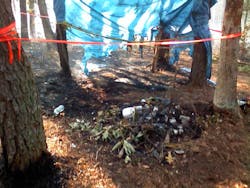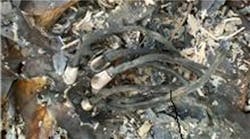In Part 2 of “Wildfire Origin and Cause Investigation,” we will continue to discuss the main points for the local fire investigator to focus on when conducting a wildfire investigation. Hopefully, last month’s article was an eyeopener for some local investigators to expand their education. The topics we will cover this month will be fire cause determination and fire cause categories/ignition sources. Investigators should become familiar with NFPA 921 and NWCG Wildfire Origin and Cause Determination Handbook. These references will aid the investigator when conducting the investigation of a wildfire.
Fire Cause Determination
Remember, as fire investigators it’s our duty to seek the truth. The goal of any fire investigation is to establish the area of origin and establish the cause of fire using the scientific method. Ignition sources may be in the form of open flames, glowing embers, mechanical or electrical sparks, friction and chemical chain reactions. When determining the fire cause, the investigator must consider the conditions and circumstances that bring together the ignition source, fuel and oxidizer. Remember, if the fire was intentionally ignited, the ignition source may have been removed from the scene.
When the point of origin is identified, the investigator should look for indicators of the cause of the fire. When examining the fire scene for ignition sources, keep these few tips in mind. Always search the area systematically, look for items that do not belong in the area, interpret burn indicators correctly and do not get overwhelmed with a large fire. Learn to concentrate on small areas and filter out the background. The investigator should classify the cause according to the ignition source or human act related to the fire. A full list of fire cause categories and classifications are listed in NFPA 921 and the NWCG Origin and Cause Handbook. Let’s briefly discuss the categories and classifications that are associated with these types of fires.
Fire Cause Categories/Ignition Sources
Incendiary: The incendiary fire is intentionally or maliciously set in which the person knows that the fire shouldn’t be ignited. These fires are often set in more than one location and are located in frequently traveled as well as remote areas. When conducting the examination at the point of origin, look for matches, lighters, or time-delay devices as shown in Photo 1. When searching for time-delay devices, look for rubber bands, matchbooks or cigarettes. The firesetter may use a number of ignition sources that include the hot set, direct set and remote set. The hot set is when the firesetter uses an open flame and starts the fire immediately. The direct set is hand carried and placed in the area. The remote set can be projected or thrown to another location. The Molotov cocktail is an example of a remote set.
Lightning: Lightning is discharged static electricity. Lightning is a frequent cause of wildfires in forested areas and can strike trees and power lines. Lightning strike indicators are scars, blowholes or glass-like clumps called fulgurites. These types of fires may smolder undetected for days or weeks before becoming an active wildfire. The investigator should conduct witness interviews if possible to determine if any storm or lightning activity was seen prior to the fire. If the area or point of origin is located in a remote area and no human activity is observed, it is possible that a lightning strike has occurred. Remember to check with the weather service and review the lightning data for at least the 15 days prior to the fire.
Campfires: Campfires are used for cooking, light, warmth and ceremonial purposes. Indicators of a campfire site are a circle of rocks within the burned area. The campfire may have seating or logs around the circle of rocks and unused fire wood. Remains of a tent and discarded food containers may be in the campsite, as shown in Photo 2. The investigator should determine if the campsite is located in an approved location. Remember, many campsites and parks have restrictions on the use of campfires and a permit is required.
Debris burning: The debris fire is similar to the campfire. These fires are used to burn garbage and other controlled burning. Indicators of a debris fire are burn barrels or incinerators. Make sure to check the condition of burn barrels for failure. The witness interview and burn-pattern indicators are the best way to confirm this type of cause.
Smoking: Discarded smoking materials have been used as a cause for many wildland fires; however the investigator must be sure that certain conditions are identified before using this cause. Under normal conditions, cigarettes generally will not start wildland fires. Remember the RH must be less than 22%. The glowing tip must be exposed to fine fuels and the tip must be oriented into the wind. The ideal outside temperature is 80 degrees Fahrenheit or greater.
This writer has conducted experiments with smoking materials at a recent fire investigation training seminar. A time-delay matchbook device using cigarettes was constructed and failed to ignite. The devices were constructed with a few different types of cigarettes and extinguished themselves in a short period of time. The investigator should keep in mind that cigarettes come from all over the world and not all are the safe type.
Railroads: Railroad fires are caused by rail operation, personnel and rolling stock. Indicators for a railroad fire include fires along active tracks with multiple areas of origins. Examine tracks for recent repair or maintenance issues. Conduct witness interviews to see if a train has passed recently. The investigator should check with other jurisdictions for recent fires along train tracks. When conducting an examination on or near railroads ensure that the train traffic is shut down and obtain confirmation of the shutdown.
Children: This type of fire is usually started by a child 12 years old or younger. The child firesetter may be motivated by curiosity or vandalism. The child firesetter usually will set fires with a group and is influenced by peer pressure. Indicators are fires located near foot paths, trails, schools or playgrounds. The child firesetter may use lighters, matches, or fireworks as an ignition source. The investigator must follow all department policies and procedures when interviewing children. The investigator should refer the juvenile to the local fire prevention office for placements in a juvenile firesetter intervention program, however, follow your department’s procedures.
Equipment: The investigator should identify any equipment in the area of origin such as mowing, grading, construction logging and land clearing. There are five main ignition sources that can cause equipment fires.
- Exhaust particles - Particles from any internal combustion engine can cause a fire. The catalytic converter can reach exterior temperatures of 1,200 degrees Fahrenheit. The particles of the catalytic converters are a major cause of fires. These types of fires are usually located on the roadside and have multiple points of origin. The hot ceramic particles are discharged from the exhaust and resemble a honeycomb or small beads, as shown in Photos 3 and 4. Remember, when working close to the roadside, safety is our first concern. Follow local, state and federal guidelines while operating.
- Lubricant and fuel - This type of fire is caused by fluid being ignited from a heat source and extends to wildland areas. The fuel fire can be caused by refueling or hydraulic lines leaking.
- Friction - Friction is heat that is created by moving objects.
- Radiant or conductive heat - Radiant or conductive heat transfer can be caused when vegetation is in contact with hot exhaust or engine surfaces. The investigator should identify any area of overgrown vegetation that a vehicle or equipment has been parked or is being stored on.
- Mechanical breakdown - Mechanical breakdown is closely related to friction. The examples of mechanical breakdowns are transmission failure, electrical, brake and tire failure.
Miscellaneous Ignition Sources
The investigator may use miscellaneous ignition sources, however, you must be prepared to support and prove your findings. Some examples of miscellaneous causes are as follows; power lines, cutting and welding operations, firearms, spontaneous combustion, flares and fireworks. Let’s discuss some miscellaneous fire causes.
Power lines: These types of fires usually result from hardware, insulator or conductor failure. The indicators of this type will be downed power lines, signs of arcing, blown fuses, or dead birds in the area of origin. Remember that it is critical that the investigator ensures that the power has been secured prior to entering the area of origin.
Cutting and welding operations: Cutting and welding operation fires can result from agricultural, industrial and residential operations. Indicators of this type of fire are welding rods, slag, and metal fragments.
Firearms: Many types of ammunition can cause a fire. Some types of ammunition are tracer rounds, steel core and incendiary. Remember, if the investigator uncovers any unexploded ordnance do not attempt to move it. This is a job for specially trained explosive ordinance disposal (EOD) personnel.
Spontaneous combustion: Certain types of fuels will spontaneously ignite from internal heating caused by biological and chemical processes. This type of fire may occur on hot, humid days in materials such as sawdust, hay, wood chips, and manure.
Flares: Flares will burn at a temperature of about 3,600 degrees and are used for industrial, military or commercial applications. Indicators of a flare fire will include flare debris such as caps, strikers and slag. Grayish slag will remain at the point of origin.
Fireworks: Fireworks are classified as handheld, ground based or aerial. These types of fires may occur during the holiday period. The fireworks can provide ignition through flaming debris and sparks. At the area of origin there may be remains of the fireworks or packing material.
Conclusion
For the local fire investigator, the wildland fire is a difficult task to complete. The conditions may be in an environment that you are unfamiliar with. Remember, when conducting the examination, always search the area systematically and look for items that do not belong in the area. Learn to concentrate on a small area and filter out the background. Take your time during the examination and do not prejudge the cause. Keep an open mind and support the facts. It was the intention of these articles to give the reader a basic over view of wildland fire investigations.
References
- NFPA 921, Guide for Fire and Explosion Investigations, 2008 ed. Quincy, MA: National Fire Protection Association, 2008. Print.
- Wildfire Origin & Cause Determination Handbook, 2005 ed. National Wildfire Coordinating Group, 2005. Print.
ROBERT DISBROW JR. IAAI-CFI is a 22-year veteran of the fire service. Rob is a career firefighter/investigator with the City Of Bayonne, NJ, Fire Department and also conducts origin and cause investigations for a forensic engineering firm based in New Jersey. He is a life member of the Laurelton Fire Co. # 1 and a fire commissioner for the Howell Township Fire District # 1. Rob holds an associate degree in fire science and is a IAAI-CFI certified fire investigator and NAFI -CFEI certified fire and explosion investigator. He is also certified as a fire inspector, hazardous materials specialist, fire instructor and juvenile firesetter intervention specialist and has been investigating fires for the past 15 years. View all of Rob's articles here. He can be reached via e-mail at: [email protected].







